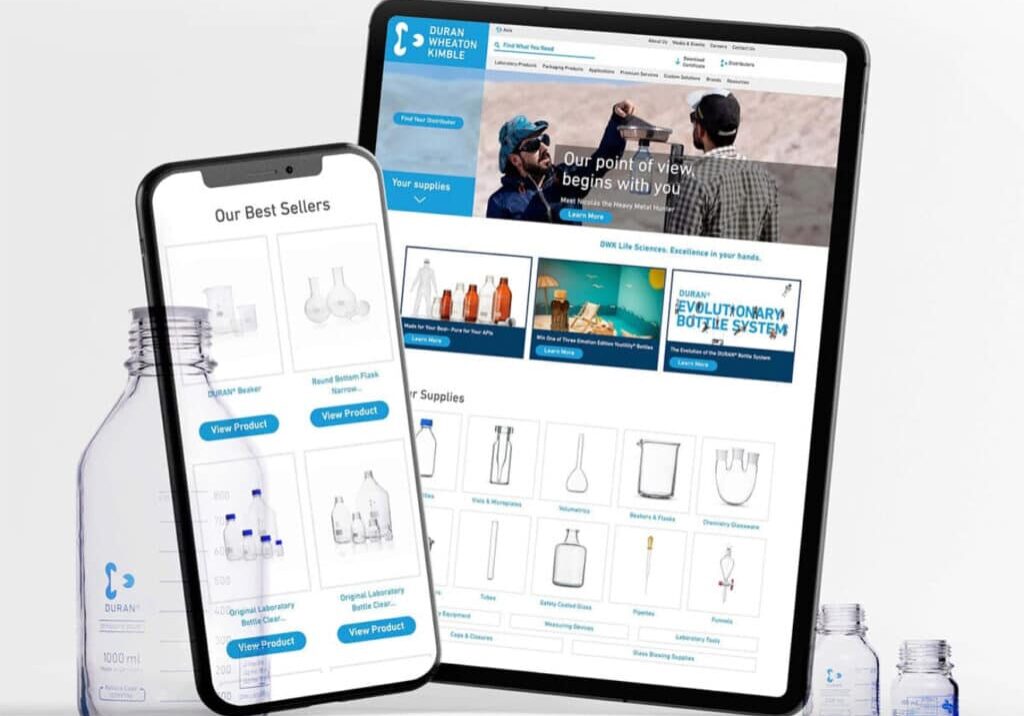Web Development, White Papers
6 Minutes
5 Challenges Life Science Companies Face During Web Development and Solutions
Developing a website is a challenging and time-consuming process. Life science websites present additional complexities depending on the purpose of the website. Whether the purpose of your site is to clearly illustrate a complex concept to potential investors looking at the website, or to sell time-sensitive products through an e-commerce platform, it’s important to understand how life science web development differs from other fields. That’s why it’s important to work with a company familiar with specificities of the industry.
Although life sciences are one sector, anyone in the field knows there is quite a broad spectrum of companies. These web design challenges are relevant for the following sectors within life sciences: drug discovery, diagnostics, lab automation, biotechnology, medical devices, pharmaceuticals, fine chemicals and APIs, or life science research tools.
SCOPING AND COST
The Challenge:
Large e-commerce websites that sell multiple complex SKUs of products or often require customizations.
Some of these customizations might include asking customers on the front end for additional information to be delivered to the company’s sales team. Other customizations involve complications with calculating shipping rates for delivering items to be shipped on dry ice or other sensitive products.
Additionally, during the time of development, often times new features are requested that involve additional design and development time.
The Solution:
Agree to a budget up front.
We have years of experience developing life science websites. Once we know what your budget is, we can tell you what is reasonable, and how to efficiently prioritize features. The goal is to best apply the 80/20 rule to your website. We understand both the science and the industry and can help determine the website’s 20% most-used functions. That way we can focus on the most important aspects instead of draining the budget on the 80% of functionality rarely used. The result will be a cleaner and goal driven website with better return on investment. If there are overlooked features, we will scope that out immediately and provide additional quotations as necessary.
PROJECT DEADLINES
The Challenge:
It can take forever to launch a website, especially if new features and customizations are being requested.
Large complex websites take potentially hundreds of hours to build. At any sought after web development firm, you can be sure they are juggling multiple clients and projects. That’s why it is important to clearly define the website from the beginning and adhere to deadlines. Especially in life sciences, the marketing manager and usual point of contact attends many conferences making it hard for the developers to get in touch. These delays dramatically slow down the site’s development because content isn’t being delivered on time and questions aren’t being replied to. Meanwhile on the developer’s side, they are wasting precious time and resources waiting around.
The Solution:
It’s the responsibility of the web developer and the client to adhere to set deadlines.
Simply put, often times we start a development project and the point of contact is overloaded with work for weeks and unable to collaborate with us. This slows momentum drastically and results in missed milestones. As the client, it’s important to only start a web development project if you know you will have availability to work together and collaborate. A web development project is much more hands on and does take time from the client if the best possible product is to be achieved.
POST LAUNCH ISSUES
The Challenge:
After a site is launched, it still might be far from perfect.
It is never the case a website is done on the day of launch. A website is a continual process of improvement. There might have been features and new product lines that you have launched since the site was initially discussed half a year ago. The site needs to have additional security updates and patches installed due to software bugs. You want to install a better linkage directly from your website’s signup form to a CRM system like Salesforce. These options all require additional development time.
The Solution:
Soft launch the website sooner than later, and start using it.
Instead of having a huge launch day where you expect suddenly thousands of new users to find the site, it is better to soft launch it when the core functionalities (80/20 rule) are complete. Meanwhile, the site is starting to generate more and more traffic, and the developers have time to polish up other side functionalities that might not be crucial. In the end, no matter how much time you have spent on the polishing up the site, it is just one day, and there still remains work to be done. It is a continual process that doesn’t end on the launch day. In the beginning of a web development contract, it is important to negotiate some sort of web maintenance retainer to start working on additional features.
MULTI PLATFORM RESPONSIVENESS
The Challenge:
Today, clients use a wide array of browsers and devices to access websites. Not all browsers are created equal.
Each resolution, browser, operating system, device presents its own array of unique problems. Widely used browsers such as Internet Explorer or even Firefox still do not fulfill all web compliance standards. This means the developer needs to be checking each platform across years of different browser versions and operating systems. This creates huge time drains for developers down the road during bug testing and delays launch. Each design change requires additional testing and start to cause downstream issues in design and functionality. This is why it’s important once again to decide on core functionalities and design elements from the beginning.
The Solution:
Have an expert level quality assurance team that is constantly regression testing the website.
Having a development team with a full time quality assurance tester to be actively working alongside the web developer is ideal. Often times the developer and graphic designer are so busy focusing on making the elements functionally work together, that they neglect bugs and other quality assurance issues. A full time bug tester can be addressing these on the fly so clients aren’t wasting their precious time informing the team of bugs.
USER EXPERIENCE AND DESIGN
The Challenge:
Life science companies deal with unique customers compared to other industries.
Often times in our field, the website is made specifically for certain unique goals. Some of these might include: explaining a difficult yet innovative concept to potential investors, selling thousands of sizes of configurable products, or clearly driving home the company’s core competencies and services and acquiring leads.
The Solution:
Find specialists in your industry, not generalists.
It’s important to work with a design and development company familiar with your competitors and the top websites in life sciences. This way, from the start there won’t be a communication gap. Having the client and the development company on the same page means less costly mistakes down the road, and a better understanding of high-level goals. There will be less back and forth during design because the graphic designer will understand who your target audience is and what is most appealing to them. Work with people who specialize day in and day out in your industry.
WRAP UP
Life science companies face unique challenges during web development. Designing a new website can be very costly and should be viewed as a long-term engagement instead of a short term solution. For these reasons, it’s important to find a company that not only has vast experience in your field with proven case studies, but also a team that you connect with well.
Our agency specializes in web development for life science companies. Our impressive client list in the life science industry speaks for itself. So, find out more about our web design and online marketing services by scheduling a free 1-on-1 consultation.
Related Posts
Get a Quote or Ask a Question
- Curious about our process or pricing?
- Need help getting buy-in?
Contact us right away — we’d love to help.
Let’s take a look at your website together and figure out your best options for business growth.

Contact us right away — we’d love to help.
Let’s take a look at your website together and figure out your best options for business growth.



